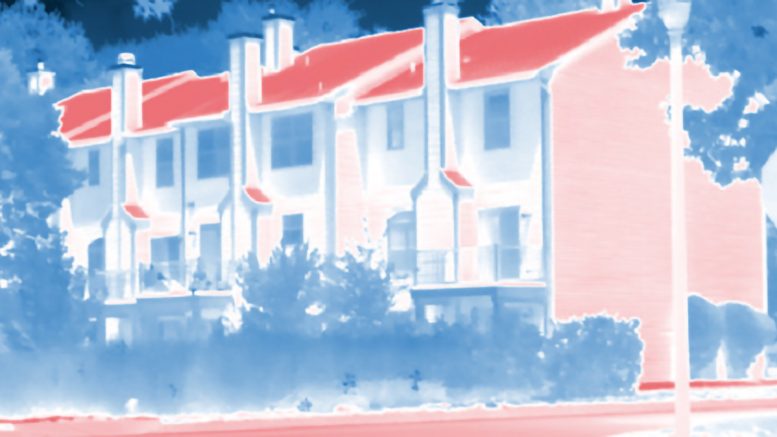博文
科学家开发出使建筑物冬暖夏凉的被动机制
 精选
精选
||
科学家开发出使建筑物冬暖夏凉的被动机制
诸平
Fig. 1 Princeton and UCLA researchers have created a new passive climate control technology using engineered coatings that manage heat transfer by specific wavelengths, potentially offering substantial energy savings and improving comfort in buildings, especially in less affluent regions. A thermal image shows heat radiating from a building. Credit: Mandal et al/Princeton University
Fig. 2 A thermal image of buildings walls and roofs. Credit: Mandal et. al./Princeton University
据美国普林斯顿大学(Princeton University)2024年7月7日提供的消息,普林斯顿大学的研究人员与美国加州大学洛杉矶分校(University of California at Los Angeles简称UCLA)、美国田纳西州的橡树岭国家实验室(Oak Ridge National Lab)以及美国亚利桑那州立大学(Arizona State University)的研究人员合作,已经开发出一种被动机制,可以在夏天给建筑物降温,在冬天给建筑物供暖(Princeton Scientists Develop Passive Mechanism To Cool Buildings in the Summer and Warm Them in the Winter)。研究人员设计了一种被动热调节机制,使用普通材料选择性地管理辐射热,为显著提高建筑能源效率和舒适度提供了一种可持续的方式。相关研究结果于2024年6月27日已经在《细胞报告物理科学》(Cell Reports Physical Science)杂志在线发表——Jyotirmoy Mandal, Jyothis Anand, Sagar Mandal, John Brewer, Arvind Ramachandran, Aaswath P. Raman. Radiative cooling and thermoregulation in the earth’s glow. Cell Reports Physical Science, 2024. DOI: 10.1016/j.xcrp.2024.102065. Published:June 27, 2024.
在此篇文章中,研究者报告说,通过将建筑物和环境之间的辐射热流限制在特定波长,用普通材料设计的涂层可以实现节能和热舒适,这超出了传统建筑围护结构所能实现的。
普林斯顿大学土木与环境工程(Civil and Environmental Engineering at Princeton)助理教授乔蒂莫伊·曼达尔(Jyotirmoy Mandal)说:“随着全球气温的升高,维持可居住建筑已成为一项全球性挑战。建筑物以辐射的形式与环境交换大部分热量,通过调整其外壳的光学特性来利用辐射在我们环境中的表现,我们可以以新的和有效的方式控制建筑物的热量。”
历史和当前的冷却技术(Historical and Current Cooling Techniques)
由电磁波携带的辐射热无处不在,当阳光温暖我们的皮肤时,或者当电线圈加热房间时,我们会感受到它。通过控制辐射热来调节建筑温度是一种常见的做法。大多数建筑使用窗帘来阻挡阳光,许多建筑将屋顶和墙壁涂成白色以反射阳光。
加州大学洛杉矶分校材料科学与工程副教授阿斯沃思·拉曼(Aaswath Raman)说:“如果我们看看希腊的圣托里尼(Santorini in Greece)或印度的焦特布尔(Jodhpur in India)等历史悠久的城市,我们会发现,通过让屋顶和墙壁反射阳光来冷却建筑物的做法已经实行了几个世纪。近年来,人们对反射阳光的凉爽屋顶涂料产生了巨大的兴趣。但冷却墙壁和窗户是一个更加微妙和复杂的挑战。”
屋顶通常可以看到开阔的天空。这使得凉爽的屋顶涂层能够反射阳光,并向天空辐射长波热量,最终到达太空。另一方面,墙壁和窗户大多能看到地面和邻近的建筑。在炎热的天气里,它们被热的街道、人行道和附近建筑物所辐射的热量所加热。这意味着,即使墙壁和窗户向天空辐射热量,它们也会被地球加热。在寒冷的天气里,陆地环境变得更冷,从墙壁和窗户排出热量。
研究人员意识到解决这个问题的方法在于热量在建筑物和地面区域之间,以及建筑物和天空之间传播的不同方式。辐射热从建筑物转移到天空的红外光谱的一个狭窄部分被称为大气传输窗口,所以研究人员称之为窄带(narrowband)。在地面上,辐射热在整个红外光谱中移动,研究人员称之为宽带(broadband)。
乔蒂莫伊·曼达尔指出,“通过在墙壁和窗户上涂上只辐射或吸收大气窗口热量的材料,我们可以减少夏季从地面获得的宽带热量,减少冬季的热量损失,同时保持天空的冷却效果。我们相信这个想法是前所未有的,超越了传统的屋顶和墙壁围护结构所能实现的。”
材料创新和未来潜力(Material Innovations and Future Potential)
研究结果的影响有两个重要原因。首先,研究人员在文章中表明,许多普通和低成本的建筑材料在窄带辐射热量,并阻挡宽带热量。已经用作壁板材料的聚氟乙烯(polyvinyl fluoride)等材料,甚至更常见的塑料,都可以用于这一目的。
阿斯沃思·拉曼说:“当我们发现聚丙烯(polypropylene)等材料(我们从家用塑料中提取的材料)在大气窗口中选择性地辐射或吸收热量时,我们真的很兴奋。这些材料看似平凡,但同样的可扩展性使它们变得普遍,也意味着我们可以在不久的将来看到它们用于建筑物的温度调节。”
乐观的第二个原因是,在建筑规模上潜在的能源影响是巨大的。研究人员指出,季节性节能的机制与将深色屋顶涂成白色的好处相当。随着全球空调成本和与热有关的伤亡人数持续飙升,这可能是有用的。乔蒂莫伊·曼达尔和阿斯沃思·拉曼计划进一步进行这项研究。
乔蒂莫伊·曼达尔指出:“我们提出的机制是完全被动的,这使得它成为一种可持续的方式,随着季节的变化来冷却和加热建筑物,并产生未开发的能源节约。事实上,我们展示的机制和材料的好处在全球南方的建筑中是最高的。因此,在资源贫乏的地区,这可能是一个更公平的解决方案,尤其是在他们看到越来越多的制冷需求和与热有关的死亡率的情况下。”
该项目的部分支持由施密特科学奖学金(Schmidt Science Fellowship)、阿尔弗雷德P.斯隆基金会(Alfred P. Sloan Foundation)和美国国家科学基金会(NSF - National Science Foundation)提供。
上述介绍,仅供参考。欲了解更多信息,敬请注意浏览原文或者相关报道。
A novel, passive radiative thermoregulation mechanism for walls and windows
Buildings lose narrowband heat to the sky but exchange broadband heat with the earth
Vertical LWIR emitters stay cooler than broadband ones in hot weather and warmer in cold
Thermoregulation by this simple and static design yields untapped energy savings
Efficient passive radiative cooling of buildings requires an unimpeded view of the sky. However, vertical facades of buildings mostly see terrestrial features that become broadband-radiative heat sources in the summer and heat sinks in the winter. The resulting summertime terrestrial heat gain by buildings negates or overwhelms their narrowband longwave infrared (LWIR) radiative cooling to space, while the wintertime terrestrial heat loss causes overcooling. We show that selective LWIR emitters on vertical building facades can exploit the differential transmittance of the atmosphere toward the sky and between terrestrial objects to achieve higher summertime cooling and wintertime heating than conventionally used broadband emitters. The impact of this novel and passive thermoregulation is comparable to that of painting dark roofs white and is achievable with both novel and commonplace materials. Our findings represent new and remarkable opportunities for materials design and untapped thermoregulation of entities ranging from buildings to human bodies.
https://wap.sciencenet.cn/blog-212210-1441596.html
上一篇:令人吃惊的研究表明,永久有毒化学物质可以穿透人体皮肤
下一篇:革命性的磁性:偏振光解锁超快数据存储和自旋电子学

